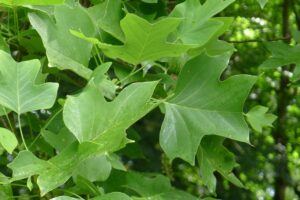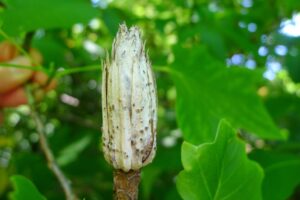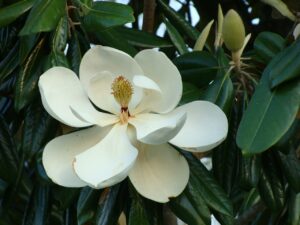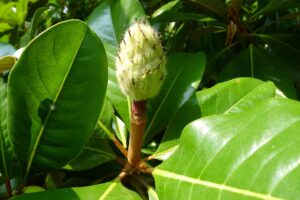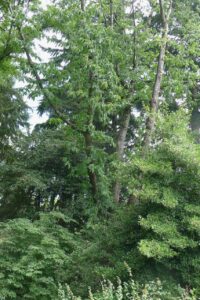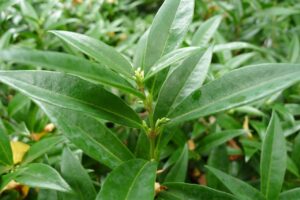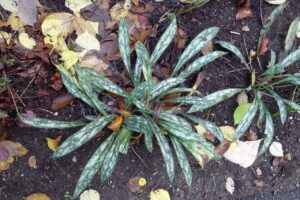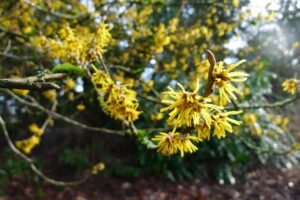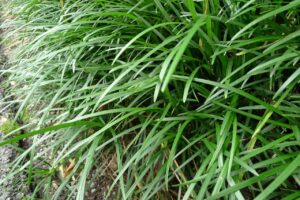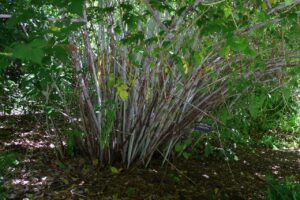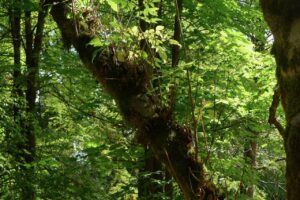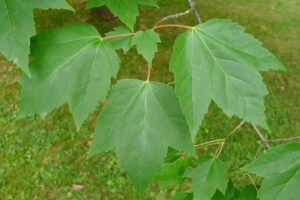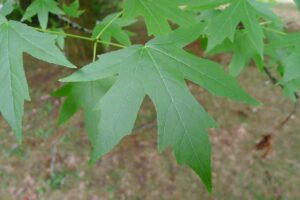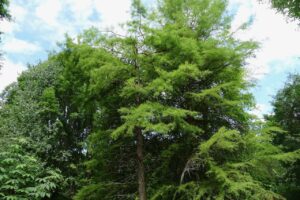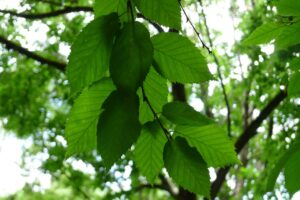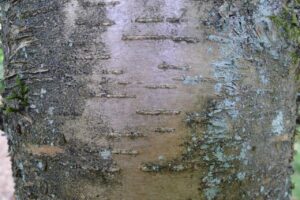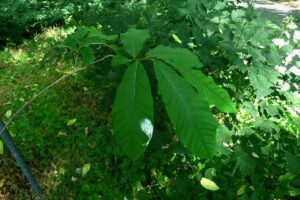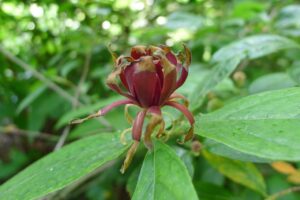Winter Takes Its Turn
Contributor: VanDusen Volunteer Sunday Guides
Download a printable PDF Version here: Winter SGT 2023
Welcome to VanDusen Garden in winter. Life remains abundant and busy in this season of change. Fruits of fall persist while plump buds herald the coming of spring. Please take a Garden map to follow this self-guided tour along VanDusen’s Winter Walk. Except at turns along the route, featured plants will be to the right. Follow the directional arrows and numbered signs.
This is the solstice, the still point
of the sun, its cusp and midnight,
the year’s threshold
and unlocking, where the past
lets go of and becomes the future;
the place of caught breath, the door
of a vanished house left ajar.
from “Shapechangers in Winter” by Margaret Atwood
To begin, exit right from the plaza and stay right. Past the “Three Carrera Marbles” (David Marshall, sculptor) look right (and up) at the spreading deciduous tree marked by the first numbered sign.
1 – Mississippi buckeye (Aesculus x bushii) is a natural hybrid of Ohio buckeye (Aesculus glabra) & red buckeye (Aesculus pavia) that occurs in the wild. The hybrid off-spring are quite variable and have showy multi-coloured flowers in spring. It is deciduous with opposite compound palmate leaves. As the buds enlarge during winter and the bud scales fall away, new spring leaves unfurl from the well-wrapped bud package, a seasonal pleasure of the buckeyes and horsechestnuts. The profuse lumpy hard fruits this tree produced in late summer are toxic due to saponins. Several steps ahead look right at the tall trunk of the next tree. 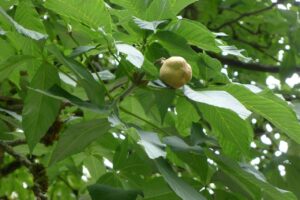
2 – Tulip tree (Liriodendron tulipifera), planted here in 1974, is native to eastern North America. Its flower and unusual leaf shape inspire its common name. This disjunct species has an east Asian counterpart represented at VanDusen by Chinese tulip trees (Liriodendron chinense) in the Sino-Himalayan garden. Disjunct refers to wide geographic separation of closely related populations. The eastern North America (ENA) – east Asia disjunct includes about 65 genera. Other disjunct species on this tour include #3, #7, #12 and #16. The evolution of Liriodendron places it in that early group of flowering plants, the Magnoliid clade, whose ancestors branched off before the divergence of the eudicot and monocot clades. The Magnoliid clade contains the Magnoliales order within which is the Magnoliaceae family to which Liriodendron belongs. This tree of ancient lineage can be a modern urban nuisance in mid-summer when aphids coat its leaves with sticky excretions that drip all over sidewalks, streets, and cars. Continue forward and just before the intersection look right at the tree with large glossy green leaves and go right at the junction corner to get a closer look.
3 – Southern magnolia (Magnolia grandiflora) is a familiar member of the Magnolia family with glossy evergreen leaves and a large fragrant flower in summer which gives it its species name. This is also a disjunct genus and another of the ancient flowering plants of the Magnoliid clade. Magnolia seeds are produced on a cone shaped aggregate of chambers (follicles) and this process can be as showy as the flowers in many species. Turn around and look across the path for the tall tree behind the carts parking pad just before the chain link service gate.
4 – American chestnut (Castanea dentata) gives a sad history lesson of the global spread of pathogens by human activity. The chestnut was once the most valuable hardwood on our continent. Chestnut blight arrived in New York on chestnuts from Asia in the early 1900s. It caused cankers that girdled the trees, which had no immunity. Within 50 years the fungus decimated vast stretches of deciduous forest and altered entire ecosystems. True chestnuts are monoecious with male flowers and female flowers on the same plant. They produce edible seeds protected by a prickly outer burr. VanDusen has a Spanish sweet chestnut, two Chinese chestnuts, and this single North American species, which is listed as critically endangered by IUCN. Head back toward the intersection to view the low evergreen shrub on the right.
5 – Sweet box (Sarcococca hookeriana var. humilis), a spreading low evergreen in the box family (Buxaceae). This dwarf variety is described by the epithet “humilis” (meaning “low”). Tiny fragrant white flowers appear in winter in the leaf axils and are followed by shiny black berries. Further along the path look for the long speckled leaves of the next plant, an herbaceous perennial.
6 – Longleaf lungwort (Pulmonaria longifolia subsp. cevennensis), native to the Cevennes Mountains of France, is a member of the borage family (Boraginaceae). Its long, narrow leaves spotted with silvery blotches and growing in a basal clump often die back in winter and may not be visible throughout this season. It typically bears its violet blue flowers just as the new leaves are emerging in early spring. Continue ahead and look for the delicate yellow blooms of the next deciduous shrub.
7 – Chinese witch hazel (Hamamelis ‘Brevipetala’) as a hybrid between H. mollis, native to China, and H. vernalis of eastern North America, embodies the ENA-east Asia disjunct. It was introduced as a cultivar in France in the mid-1930s. The cultivar name means “short petals”. Its filamentous yellow flowers cluster in late winter on bare branches and perfume the air. Go forward and look low for a grass-like groundcover.
8 – Mondo grass (Ophiopogon japonicus) forms a dense, tufted evergreen groundcover, sometimes also called lilyturf. This native of east Asia is in the asparagus family (Asparagaceae). Continue ahead and look for the white arching canes of the next plant.
9 – Ghost bramble (Rubus lasiostylus var. hubeiensis) is native to Hubei, China. Its graceful arching canes and the silvery white waxy bloom coating its stems make it striking in winter once it is bare of leaves. Rubus is a widespread genus of the rose family (Rosaceae) found on all continents except Antarctica. The small seeds in the drupelets of Rubus fruits are transported by birds. This Rubus spreads by suckering and also by stem tips rooting where they touch the ground. Turn around here and go right at the junction. Just a few steps forward turn to face the lawn in the direction of the Visitor Centre to view another forest tree of North America.
10 – Green ash (Fraxinus pennsylvanica ‘Cimmaron’) is a fast growing, seedless cultivar valued for its fall colour. The three specimens here seem to have an unusual amount of water sprouts, the bursts of upright twigs visible on the branches at several growth nodes. Ash trees have long been a significant part of deciduous forests of Canada and USA. Their populations east of the Rockies over the past twenty years have been drastically reduced by the deadly emerald ash borer beetle of eastern Asia, which likely arrived in the 1990s. It attacks woody plants of the olive family, Oleaceae. Turn back to the junction and go right to two deciduous trees of different genera.
11 – Red maple (Acer rubrum ‘Red Sunset’) is a cultivar developed in Oregon. A feature which identifies this tree as a maple is the opposite buds on its twigs and branches. In spring its tiny flowers will develop into paired winged seeds. A few steps ahead is another tree that bears palmate leaves that might be mistaken for maple leaves.
12 – Sweet gum (Liquidambar styraciflua ‘Worplesdon’) has palmate leaves whose pointed tips make them nearly star shaped. It may have corky ridges on its branches. Liquidambar fruit is a spikey ball and several may still be seen hanging on the tree. Look closely at the tree’s bud arrangement on its twigs and branches. The buds are alternate unlike the maples. Both cultivars were selected for VanDusen’s fall colour arboretum for their reliable reds. Liquidambar is the only genus of the Altingiaceae family consisting of about 15 species, another disjunct genus found in east North America, east and southeast Asia, and eastern Mediterranean. An Asian species, L. formosana, is in the Sino-Himalayan section of VanDusen. Continue ahead to the next sign and look back and up for a tree with a broken top.
13 – Bald cypress (Taxodium distichum) was damaged in the storms of December 2022. Broken topped bald cypresses are not uncommon in their hurricane prone native range in southeastern North America. They can survive such damage and may live more than 2000 years. This is a deciduous conifer that tolerates flooding. It is the state tree of Louisiana. Continue ahead and go right at the junction. Look for arrows on the right side of the paved path directing you onto a woodland path to the next tree.
14 – Yellow birch (Betula alleghaniensis) is the provincial tree of Quebec. Its bark is a shiny golden bronze, accented by horizontal lenticels. Birches are monoecious with separate male and female flowers on the same tree and are wind pollinated. Return to the paved path and continue ahead to a small deciduous tree near the path.
15 – Pawpaw (Asimina triloba) is a small tree native to eastern USA and Canada (southern Ontario). It is the northernmost member of the custard apple or soursop family (Annonaceae), which has more than 2000 species, mostly in tropical and subtropical regions. It is another of the ancient flowering plants of the Magnoliid clade and the Magnoliales order. The specific epithet “triloba” refers to the three sepals and six petals of the red-purple flowers, which are insect pollinated and not self-fertile, needing other paw paws nearby to set their large edible fruits. Continue along the path to the last plant, another ancient flowering plant that is also in a disjunct genus.
16 – Carolina allspice (Calycanthus floridus) is native to eastern USA. VanDusen has specimens of Calycanthus chinensis, native to east Asia, and Calycanthus occidentalis, native to western USA, in addition to several specimens of this species. Calycanthus belongs to the Magnoliid clade in the order Laurales and the family Calycanthaceae. Its leaves and flowers are aromatic but contain toxins and should not be eaten or used for flavoring food.
Our tour ends here. Thank you for visiting VanDusen Botanical Garden today.

